
By Mark van der Feyst
Our self-contained breathing apparatus (SCBA) is one of the most important pieces of equipment that we use daily. It protects us from immediately dangerous to life or health (IDLH) atmospheres and has been considered the key in the advancement of the fire service today. Our SCBA has evolved through the ages; we now have very modern looking SCBAs compared to the first generation SCBAs.
However, we need to be aware of our SCBAs’ limitations and how to overcome them. Our SCBA limits our vision, especially peripheral vision; limits our ability to communicate and hear; adds extra weight on our backs; limits air supply time; and limits our ability to move around with ease.
Our SCBA adds extra profile to our bodies that hinders our ability to move around or through obstacles. In our basic training, we have all been presented with an obstacle that requires us to somehow reduce our profile so that we can pass through it. This technique, called “low profiling,” is now being taught in firefighter survival classes as a way of self-rescue. It has been around well before firefighter survival training started to emerge, and we need to go back to the basics of knowing our equipment and how to use it. Low profiling is one of those techniques that we should all know and practice.
Whenever we reduce our profile, we are taking an inherent risk. We normally want to keep our SCBA on our backs at all times. From the moment we don our SCBA in the back of the apparatus, we usually want to keep it on until we come out of the structure and doff it. When we doff our SCBA (or partially remove it) within an IDLH atmosphere, we are increasing the risk of exposure to a potentially bad situation. Our SCBA can be lost if this technique is not executed properly; or it can become entangled; or we may not extend the straps all the way or drop the SCBA down a hole in the floor, thus losing our air supply.
All of these listed risks need to be eliminated or managed in such a way so that we reduce the chance of a potentially bad situation. The only way to manage these risks is to become familiar with low profiling so that we are proficient with this execution.
The Three Methods
There are three methods in which we can reduce our profile. The first is to simply loosen the straps of the SCBA (but keep the SCBA on). By loosening all of the straps (waist strap and shoulder straps), we are allowing the SCBA to move freely on our back. By doing so, we can navigate through any smaller size opening, allowing the SCBA to either move to one side or the other. Once we pass through the opening, we can then retighten the straps and carry on with our mission.
In a survival instance, retightening the straps is not that important; we want to exit the structure as fast as we can. In a search operation, it will be prudent to retighten the straps. If the straps are not retightened, they can become an entanglement hazard as well as allow the SCBA to fall off. This will slow you down and make you ineffective.
We need to make sure that we are extending the straps all the way open. Many firefighters will only loosen the straps a little. This will still allow you to doff your SCBA or move it to one side, but when it comes time to re-don the SCBA, you will have trouble. Remember, while you are wearing structural firefighting gloves, you will lose some of your dexterity and feel. This will slow you down when trying to re-don the SCBA. If the straps are extended all the way open, you will ensure a quicker and easier time re-donning your SCBA.
The second method involves loosening the straps and doffing just one side of the SCBA. Photo 9 shows the firefighter has moved his SCBA to one side of his body. This profile will allow the firefighter to fit through tighter obstacles. Depending on the size of the firefighter, this may be the preferred method of reducing your profile. This technique requires all straps to be loosened and then you remove one shoulder strap from your body. The shoulder strap that contains your regulator needs to stay on your body; this will protect the regulator from being pulled apart from the face piece.
Once the SCBA is on the side of your body, you will be able to maneuver through and bring the SCBA along with you. Once through the obstacle, you will be able to don the SCBA. It is important to sound the floor when you are going through any type of obstacle. You need to make sure that a floor exists to sustain your weight.
RELATED: Windisch: Check, Maintain, and Document SCBA and PPE ‖ Ponder on the Evolution of SCBA and Training Innovations ‖ Carroll on Mayday Monday: SCBA Confidence Drill
The third method is the riskier method; this involves removing your SCBA completely and passing it through the obstacle in front of you, then re-don the SCBA afterward. As mentioned before, the straps will need to be fully extended before you remove your SCBA.
In photo 1, the firefighter has an opening only 14 x 14 inches to go through. He has used his tool to sound the floor on the other side of the wall. He now knows that there is a floor complete with no holes in the immediate vicinity.
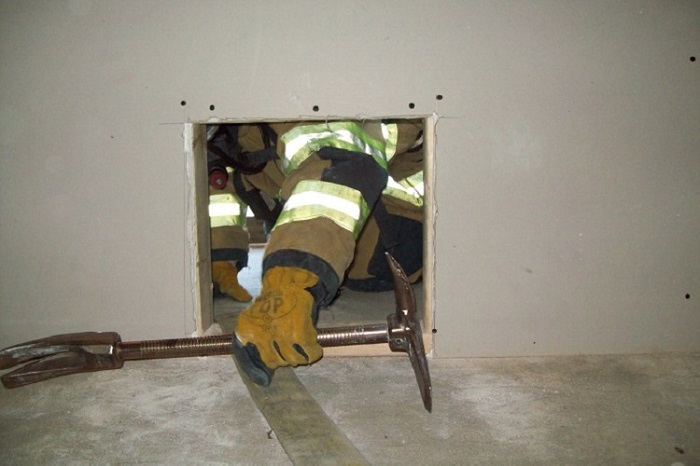
(1) Photos by author.
This is important to check because, as you pass your SCBA through the opening, if there is a hole in the floor that you missed, your SCBA will go for a ride, and so will your face and regulator.
In photo 2, the firefighter is now preparing to remove his SCBA. He is extending his straps fully.
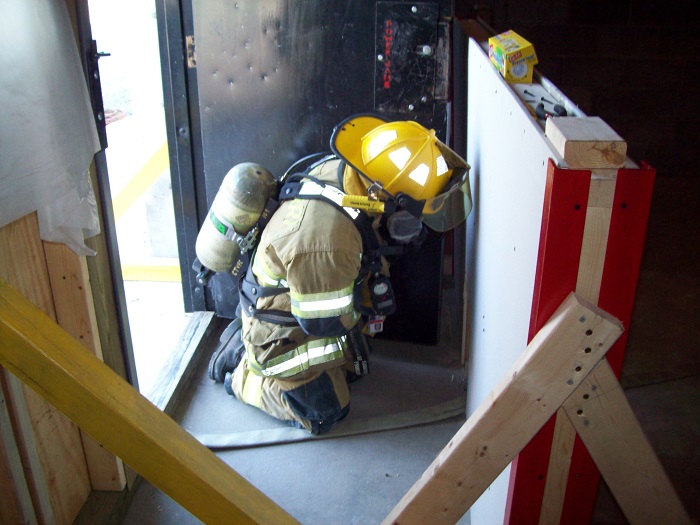
(2)
In photo 3, the firefighter now has his SCBA off his back. He is going to be protecting his regulator by holding onto the right shoulder strap.

(3)
In photo 4, the firefighter is now passing his SCBA through the opening.
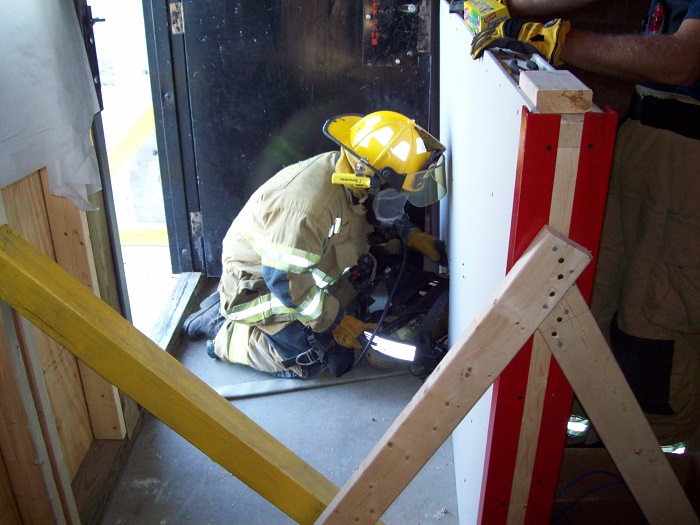
(4)
In photo 5, we can see from the other side of the wall how the firefighter’s SCBA is being passed through. He has a firm grip on his right shoulder strap to protect his regulator and to make sure that he does not lose his SCBA.
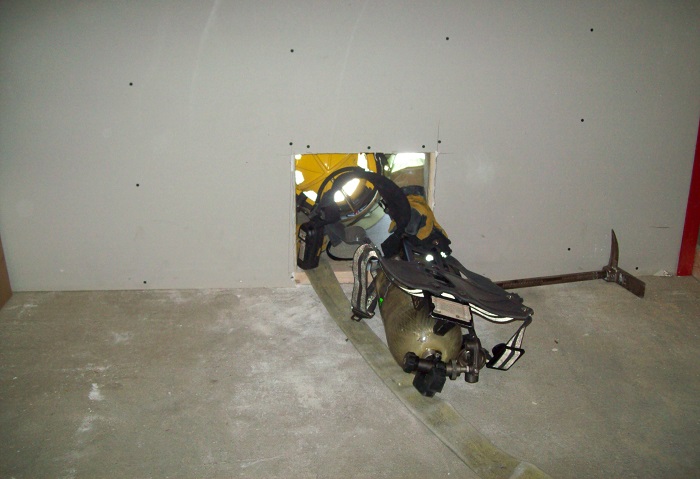
(5)
Notice the tool lying right next to the wall; this is done so that when the firefighter is ready to move on, he can easily locate the tool. Many times, we will throw our tool through the opening and let it fall where it may. This is not what you want to do; this will only allow you to lose your tool and create more of a panic.
In photos 6 and 7, we can see the firefighter making his way through the opening. Once through, he is now going to re-don his SCBA, as seen in photo 8.
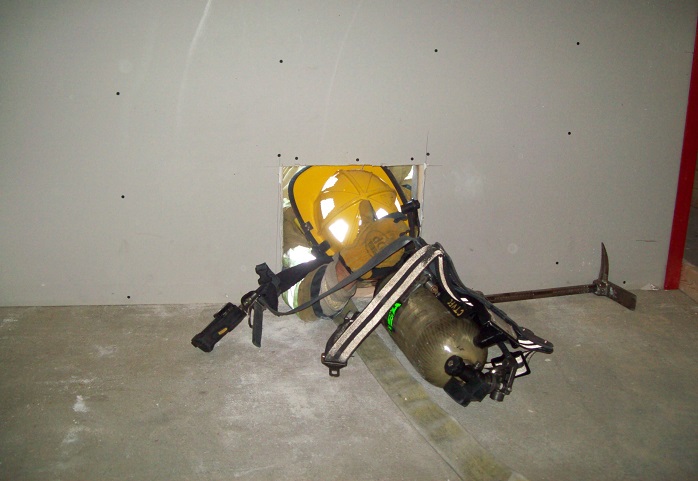
(6)
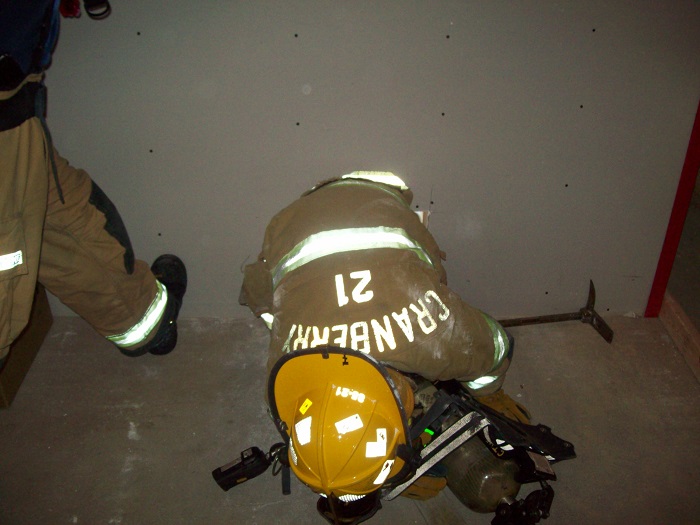
(7)
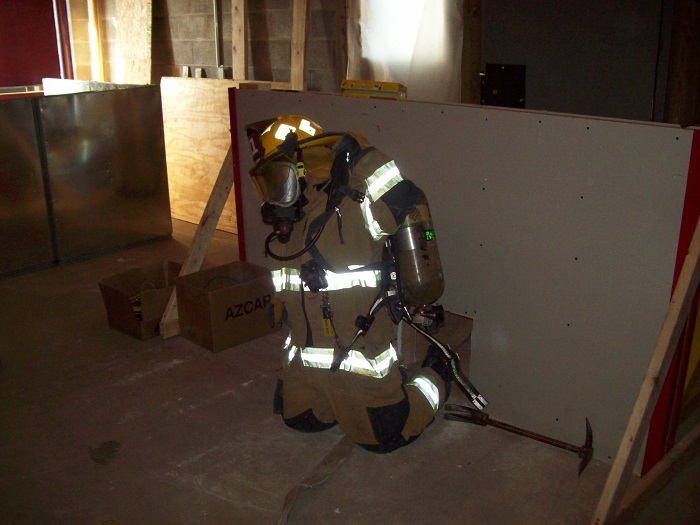
(8)
In photos 9 and 10, we can see another example of an SCBA being passed through an opening. This firefighter does not have a firm grip on his SCBA. He is holding it with both hands on the side of it, pushing it in front of him. Is he sounding the floor? Are there any holes in front of him? If there are, his SCBA will definitely fall through the opening with no chance of him stopping it. Be sure you have a firm grip on the shoulder strap that contains the regulator. In photo 9, we can see the firefighter protecting his regulator by having the left shoulder strap still on his body.

(9)

(10)
The opening that he went through was only 14 x 14 inches. This is a typical opening since stud walls are spaced 16 inches on center, allowing a 14-inch opening between the studs. A good drill to practice is to make this size hole and make everyone go through it at least once. You will be surprised that even the biggest person on your department will fit through using certain techniques such as low profiling. It is also a good confidence builder for each member.
Another method for completing a wall breach or reducing your profile is the swim technique, which involves keeping the SCBA on your back, (maybe) loosening the shoulder straps if need be, and “swimming” backward through the opening.
In photo 11, the firefighter is placing his SCBA cylinder into the opening of the breach.
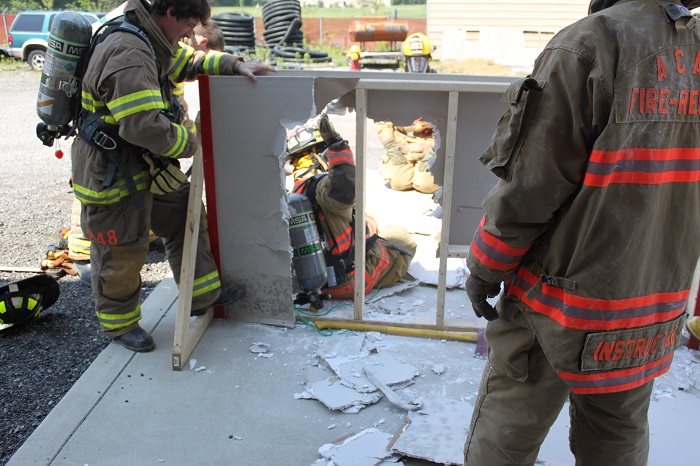
(11)
The cylinder should be positioned into the corner of the opening to allow for one arm to rotate up and behind the firefighter (as seen in photo 12).

(12)
Once the firefighter has one arm through the opening, the other arm will also be rotated up and behind him, going through the opening. At this point, the firefighter’s body should be about halfway through the opening. All that is needed now is for the firefighter to use his legs to push himself completely through the opening (as shown in photo 13).
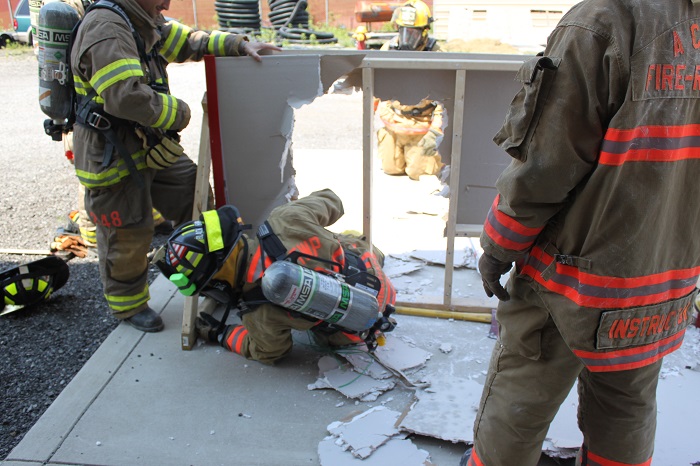
(13)
Once the member is through the opening, he is now able to get to the nearest exit point to quickly exit the structure.
Mark van der Feyst has been in the fire service since 1999 and is a full-time firefighter in Ontario, Canada. He is an international instructor teaching in Canada, the United States, and India, and at FDIC. He is a local level suppression instructor for the Pennsylvania State Fire Academy and an instructor for the Justice Institute of British Columbia. He is also the lead author of Residential Fire Rescue (Pennwell).

